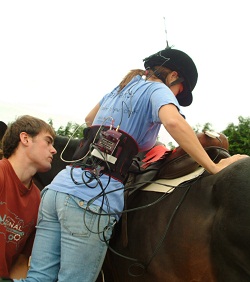What’s good for the horse isn’t good for the rider, report finds
Published On Thu 3 Apr 2014 by Grant Hill

Saddles that best protect horse riders from spinal damage have the opposite effect on their mount, according to new research from the University of Dundee.
Horse riding can cause degenerative spinal injury to both rider and horse due to the dynamic pressure that the activity exerts on them. The study by researchers led by Professor Rami Abboud in the University’s Institute of Motion Analysis and Research examined how the flocking (cushioning) material of a saddle affected the pressure on humans and animals.
Pressure recordings were carried out on a saddle fitted with wool, the most common flocking material, and compared to those taken from one with air-filled panels as part of the Masters studies of one of the team, Dr Graeme Nicol. It was previously known that wool-flocking can cause back pain for horses but the results show that, while air-flocking reduces the pressure exerted on the horse, it increases the pressure exerted on the rider at the same time.
The researchers say that the study demonstrates that further research needs to be conducted to determine the most appropriate material to cushion a saddle with in order to protect both horses and their riders from spinal injury.
“There is a higher incidence of cervical and lumbar degenerative spondyloarthropathy in experienced horse riders and degenerative changes are produced by a combination of mechanisms,” explained Dr Nicol.
“The rider’s posture causes the muscles in the back to contract to balance the spine and prevent injury, which leads to large compressive forces being produced resulting in greater pressure placed on discs and joints. Ground reaction force (GRF) is another contributing factor. It is an equal and opposite force to the force exerted by the rider on the saddle. These forces applied repetitively over time may lead to injuries such as degeneration of joints, lower back pain and fatigue fractures.”
Both flocking materials were tested during a variety of different gait settings using two pressure mats to record the pressures firstly being exerted onto the horse and secondly onto the rider. Saddle cushioning material may directly affect GRF and in so doing may reduce the extent of degenerative changes seen in the spine of the rider while saddle-fit is a recognised factor in equine back problems.
“We have shown that air-flocked saddles exert less pressure on the horse, but impact inversely on the rider. This raises the question of whether a rider should use a saddle to reduce the pressure on the horse or on themselves,” indicated Professor Abboud.
Six experienced riders and one healthy horse in regular training were selected for the study. Although the riders were of varying heights and weights, they had similar riding abilities and their own unique riding style. Despite these differences, it was consistently shown that air-flocked saddles increased the pressure on the rider while the horse experienced more with the wool-flocked saddle.
All riders said they preferred the wool flocking, citing a variety of reasons including a loss of close contact and interaction with the horse and a ‘‘kick back’’ from an unstable-feeling saddle with air flocking.
Results found that both the mean peak pressure (MPP) and mean pressure–time integral (PTI) exerted on the rider increased by as much as 21.9% and 22%, respectively, following conversion to air flocking. In contrast, the air flocking saddle exerted a lower MPP and PTI on the horse by as much as 25.3% and 26.6%.
Dr Nicol continued, “One explanation for the increase in pressure on the rider following conversion to air flocking is they frequently noted they had lost some of the feeling of the horse below them, and for this reason they may have subconsciously increased the pressure they exerted through their seat and less through the stirrups in an act to maintain horse response.”
“Our results will hopefully help in the future when examining further studies and also encourage further research into the understanding of the shock attenuation properties of different saddle flocking materials. As a result this will hopefully allow the optimum materials for saddle manufacture to be discovered in the hope of avoiding preventable injury’s occurring to both horse and jockey.”
The study was approved by the University Research Ethics Committee in consultation with the Home Office inspector for projects conducted on animals, and the resulting paper has been published online by the Sports Engineering journal.
For media enquiries contact:
Grant Hill
Press Officer
University of Dundee
Nethergate, Dundee, DD1 4HN
TEL: 01382 384768
E-MAIL: g.hill@dundee.ac.uk
MOBILE: 07854 953277